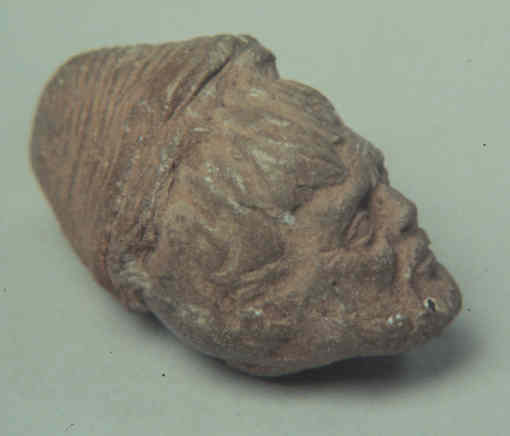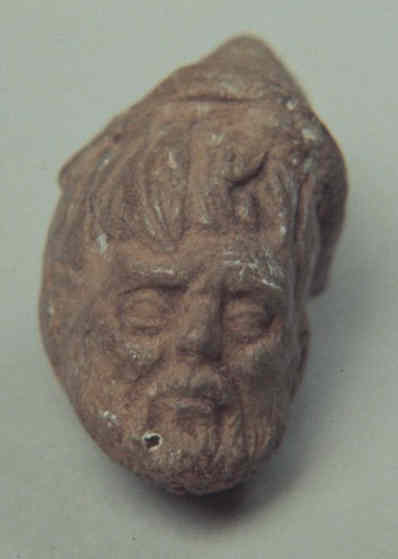The Calixtlahuaca Head

Photo copyright Romeo Hristov

Photo copyright Romeo Hristov
Photo copyright Romeo Hristov
 In 1933, archaeologist José García Payón
discovered a small
head with "foreign" features in a burial at Calixtlahuaca, in
the Toluca Valley about 60 km. west of Mexico City. The burial
was under two undisturbed cemented floors that antedated the
destruction of Calixtlahuaca by the Aztecs
in AD 1510. Numerous cultural
pieces found with the head were identified by García Payón
as belonging to the Azteco-Matlatzinca period of 1476-1510.
Cortez did not land at Veracruz until 1519, and
did not conquer the Aztecs until 1521, so that central Mexico
was still pre-Hispanic in 1510.
In 1933, archaeologist José García Payón
discovered a small
head with "foreign" features in a burial at Calixtlahuaca, in
the Toluca Valley about 60 km. west of Mexico City. The burial
was under two undisturbed cemented floors that antedated the
destruction of Calixtlahuaca by the Aztecs
in AD 1510. Numerous cultural
pieces found with the head were identified by García Payón
as belonging to the Azteco-Matlatzinca period of 1476-1510.
Cortez did not land at Veracruz until 1519, and
did not conquer the Aztecs until 1521, so that central Mexico
was still pre-Hispanic in 1510.
In 1961, the Austrian anthropologist Robert Heine-Geldern examined the head and declared that it derived "unquestionably" from the Hellenistic-Roman school of art. He found that its "distinctive Naturalism" suggested a date "around AD 200." Heine-Geldern was an expert on South-East Asia, but he reported in a communication quoted by García Payún (1961) that his view that it was Roman from circa AD 200 had been confirmed by Prof. Boehringer, then president of the German Archaeological Institute. [Paragraph revised 6/5/00.]
The head was then largely forgotten until 1990, when archaeology student Romeo Hristov began a search for it. Two and a half years later, he located it in storage in the National Museum of Anthropology in Mexico City, misclassified as Colonial (catalog No. 20-1416). Hristov and Genovés (1999) review the circumstances of the discovery and the published literature relating to it. On its rediscovery, see Hristov (1994). Hristov is currently (8/00) associated with the Dept. of Anthropology at the University of New Mexico. Click here for his homepage.
In an interview in one of the leading Italian newspapers, prompted by the Hristov and Genovés paper, Prof. Bernard Andreae, the current director of the German Archaeological Institute in Rome, gave his opinion of the head: "It is Roman without any doubt... The stylistic examination tells us, more precisely, that it is a Roman work of the second century after Christ. It presents, in the cut of the hair and the shape of the beard, traits typical of the Severian emperors, exactly the 'fashion' of the period. On this there is no doubt." (Andreae, 2000, my improvised trans.) The Severian dynasty included Septimius Severus (AD 193-211), Alexander Severus (AD 222-235), and a few intermediate emperors. This period seems mostly third century, rather than second century, to me, but Andreae's comments do confirm Heine-Geldern's original date of "around AD 200."
The Forschungstelle Archäometrie at the Max-Planck-Institut für Kernphysik in Heidelberg, Germany, has performed a thermoluminscence (TL) test on material from the head to determine the time that has elapsed since its manufacture. Technical difficulties prevented the determination of a precise TL date, but the lab did conclude that "the figurine has an apparent TL age range of between 730 years and 2880 years" (Wagner 2000). This age range (870 B.C. - 1270 A.D.) does suggest that the Head is pre-Columbian, contrary to its classification as Colonial by the Museum. However, in a comment on the Hristov and Genovés paper, Schaaf and Wagner note that this result "is of only limited use in the debate about the head's origin. It probably rules out a Colonial manufacturing date for the figurine. Although it does not disprove the alleged Roman manufacturing date, it certainly should not be used in support of such a date in view of its relatively low accuracy" (2001, p. 80).
The determination that it is specifically Roman from circa AD 200 therefore relies entirely on the artistic evaluations of Heine-Geldern, Boehringer and Andreae, since the TL age range is consistent with many other pre-Columbian posiblities. (A more precise TL date given in the Hristov and Genovés article, viz. 1780 ± 400 B.P., was based on a preliminary calculation made from the same test results, but should now be disregarded in light of Wagner (2000) and Schaaf and Wagner (2001). See Hristov and Genovés (2001) for further details and a reply to other objections to the find.)
Even granting the possibility that a Roman ship might have reached the New World 1800 years ago, how could a relic of such a visit have ended up in a barely pre-Hispanic Mesoamerican burial? Hristov and Genovés cite two dozen instances in which clearly older Mesoamerican objects appear in later burials. The most dramatic of these is a 3000-year-old greenstone Olmec mask that was found in a 500-year-old Aztec burial offering inside the Great Temple of Mexico-Tenochtitlan.
It is of interest that a small hoard of Roman coins, dating to several decades after the Severian period, was found in 1963 during construction work on a bridge over the Ohio River opposite Louisville, Ky.
Update 11/11/10: See also the discussion by Michael E. Smith of Arizona State University, "The 'Roman Figurine' Supposedly Excavated at Calixtlahuaca," at www.public.asu.edu/~mesmith9/tval/RomanFigurine.html, as well as Hristov's rebuttal at www.unm.edu/~rhristov/calixtlahuaca.html. Hristov corrects some inaccuracies in the in the 1999 Dallas Observer article by Christine Blederman, at www.unm.edu/~rhristov/publicoutreach.html.
Bernard Andreae, interview (in Italian), Corriere della Sera (Milan), Feb. 27, 2000, p. 20.
Blederman, Christine, "Romeo's Head," The Dallas Observer, August 25, 1999, online at www.dallasobserver.com. Click on the continuation buttons for all 4 parts.
García Payón, José, "Una cabecita de barro, de extraña fisonomía," Boletín INAH 6:1-2 (1961).
Heine-Geldern, Robert, "Ein r&oum;mischer Fund aus dem vorkolumbischen Mexiko," in Anzeiger der Österreichischen Akademie der Wissenschaften, Philosophisch-Historische Klasse Nr. 16 (1961), 117-119, translated in Anthropological Journal of Canada 5 (1967), 20-22.
Hristov, Romeo. "The Little 'Roman' Head of Calixtlahuaca, Mexico: Some Reflections," NEARA Journal Vol. 28, #3&4, 1994. Online at http://www.neara.org/CARLSON/romehead.htm.
Hristov, Romeo, and Santiago Genovés, "Mesoamerican Evidence of Pre-Columbian Transoceanic Contacts," Ancient Mesoamerica 10 (1999), 207-13.
Hristov, Romeo, and Santiago Genovés. "Reply to Peter Schaaf and Günther A. Wagner's 'Comments on "Mesoamerican Evidence of Pre-Columbian Transoceanic Contacts,"'" Ancient Mesoamerica 12 (2001), 83-86.
McCulloch, J. Huston. "Roman Coins from the Falls of the Ohio," website at www.econ.ohio-state.edu/jhm/arch/coins/fallsoh.htm, 9/05/01.
Schaaf, Peter, and Günther A. Wagner. "Comments on 'Mesoamerican Evidence of Pre-Columbian Transoceanic Contacts,' by Hristov and Genovés, in Ancient Mesoamerica 10:207-213, 1999," Ancient Mesoamerica 12 (2001): 79-81.
Wagner, Günther, letter to New Scientist April 8, 2000 (no. 2233), pp. 64-65.